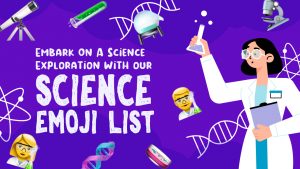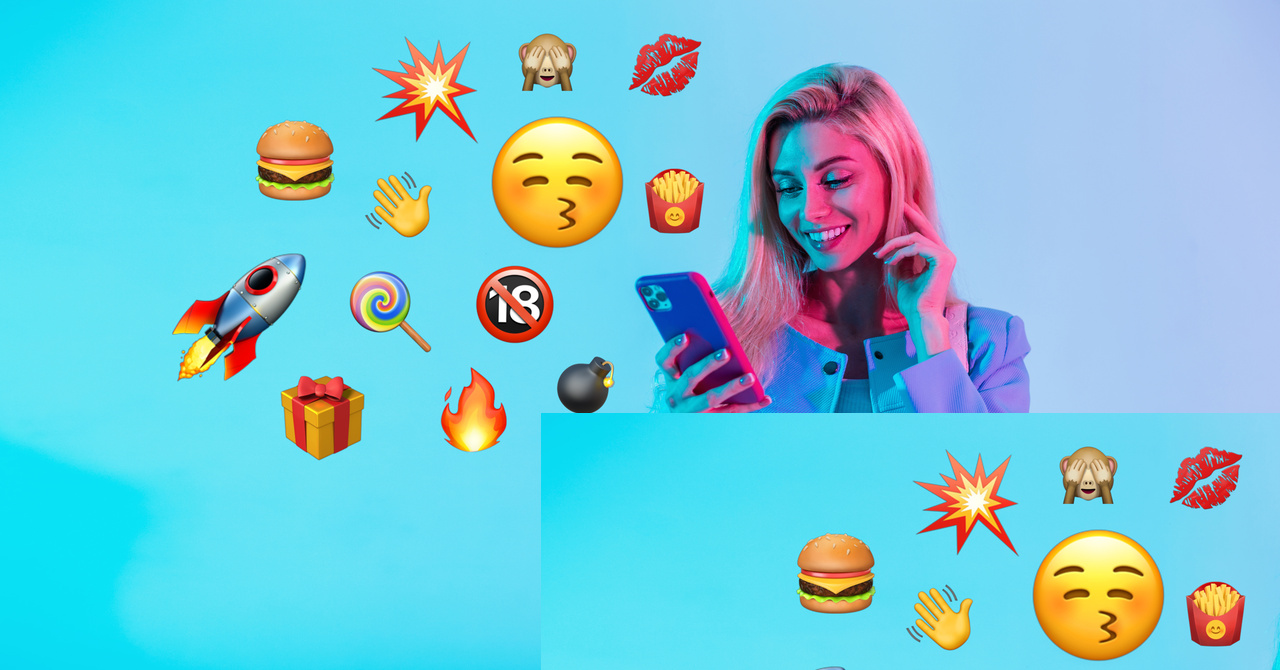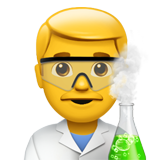Embark On A 🚀 Science Exploration With Our 🧪 Science Emoji List


Now, more than ever, we need to stand up for science. We need people who care about science and who will fight in the name of science. Imagine a world without scientists. There would be no medicine, computers, electric lighting, or all the things we take for granted. Without science, there is no option for a better world. How scary is that!
With everything that’s happened in the past few years, it’s more critical than ever to get people involved in the study of science, to have people go on explorations, make new discoveries, and learn new things! A small way but effective way to get it started would be through the use of science emoji.

Photo from Adobe Stock
Emojis and science seem like two faraway concepts, but really, they aren’t. Emojis, those cute little characters we love to include in our online chats or Facebook posts, are a huge part of our everyday technology.
Along with other great scientific inventions like social media, cloud computing, and artificial intelligence, emojis have radically changed our day-to-day lives.
Facebook reports 5 billion emojis sent each day on Messenger, and 600,000 of the 21 million tweets sent every hour on Twitter comprise at least one emoji.

Photo from Adobe Stock
Science Emojis In Our Lives
Ready to learn more about different science emojis? We’ve got just the thing for you, as you go on your exploration!
To ensure you use science emoji properly, to inform, engage and delight your audience (of course!), we’ve compiled a list of 10 major science emojis, and explained how to use them.
Microscope Emoji

Discover the unseen and exclaim “Eureka!” with the 🔬Microscope emoji! This emoji features a white or gray microscope, commonly used in science and research laboratories. Netizens often combine it with the 🦠 Bacteria emoji or the 🧬 DNA emoji, as these are the most common things observed under a microscope. Meanwhile, some use it to introduce and educate aspiring scientists on some of the common lab tools.
Test Tube Emoji

The 🧪 Test Tube emoji features a glass test tube tilting to the left. Inside the tube is a bubbling green liquid. Most platforms depict their test tubes with green liquid in them.
This emoji is best used when sharing a science-based post or reposting related to a chemical reaction. In this situation, the tone of the post doesn’t matter. It can be a news post, an informative post, or even a joke or meme. For scientists, it is normally used to emphasize experiments. Those who are not scientists most often use the emoji to denote mixing drinks.
Moreover, the test tube is used to refer to alchemy, too. This shouldn’t surprise anyone, because alchemy is a form of chemistry practiced in the Middle Ages.
Petri Dish Emoji

The 🧫 Petri Dish emoji shows a petri dish containing a specimen. A petri dish is a circular, shallow, transparent dish used for the culture of microorganisms. Its emoji form shows the dish open or partially covered, depending on the platform. Users share this emoji when they discuss topics related to culturing, incubation, and growing microorganisms.
DNA Emoji

Accentuate your genetics-related posts with the 🧬 DNA emoji. This emoji depicts chromosomes as colorful, twisted, ladder-like strands. It symbolizes genes, genetics, and heredity. Moreover, the DNA emoji commonly appears in topics pertaining to medicine, science, and anatomy. From time to time, users refer to it as the chromosome emoji, or molecule emoji.
Use the DNA emoji while sharing a social media reel, post, or repost about genes. In this endeavor, the tone of the content you use does not matter. It can be a humorous post jokingly blaming your parents or genes for your bad dancing skills or a serious news bit about gene splicing.
Microbe Emoji

The 🦠 Microbe emoji shows a group of bacteria grown in a Petri dish or seen under a microscope. Generally depicted as a one-celled microorganism with prominent cilia, it appears as a symbol for viruses, germs, and bacteria.
If you’re talking about a virus online, whether it’s a news-related bit, a meme, or even a gif, you should definitely use the microbe emoji in your conversations, emails, posts, or captions.
Alembic Emoji

This emoji shows an alembic, a rounded beaker used to distill, purify, or separate substances. It first appeared as a tool in medieval alchemy and has stood the test of time. It’s still in use today. Online, it appears as a round glass bottle with a small spout facing the right side and some liquid inside. The color of the liquid varies from platform to platform.
Although its official name is ⚗️ Alembic emoji, it’s sometimes known as beaker emoji. This emoji conveys something being invented or tested chemically. Moreover, thanks to the alembic’s association with alchemy, this emoji is sometimes used to bring a magical vibe to a conversation or post, as well.
On a separate note, because of its resemblance to a glass pipe, it is often used to symbolize a bong as well, a filtration device generally used for smoking tobacco or marijuana.
Man Scientist Emoji

This emoji shows a cartoon image of a male scientist. He has short hair, parted to one side, is wearing a pair of goggles, and a white lab coat. The scientist is holding a test tube filled with liquid.
The 👨🔬 Male Scientist emoji is often used to represent a man who works as a scientist, a scientist regardless of area of expertise. On a wider scale, users include this emoji in various content concerning science and research, as well. Netizens share this emoji when they want to express a strong desire for innovation and experimentation, too.
The male scientist emoji comes in five skin tone variations:
- 👨🏻🔬 Light Skin Tone Male Scientist,
- 👨🏼🔬 Medium-Light Skin Tone Male Scientist,
- 👨🏽🔬 Medium Skin Tone Male Scientist,
- 👨🏾🔬 Medium-Dark Skin Tone Male Scientist, and
- 👨🏿🔬 Dark Skin Tone Male Scientist.
Woman Scientist Emoji

The emoji features a female scientist in a lab coat, holding a test tube filled with liquid. She is sporting long brown hair and is wearing protective goggles. The 👩🔬 Female Scientist emoji depicts female scientists in any field of science, at any level, whether new or experienced. Just like her male counterpart, netizens share her to express a strong desire for innovation and experimentation.
The female scientist emoji comes in five different skin tones as well:
- 👩🏻🔬 Light Skin Tone Female Scientist,
- 👩🏼🔬 Medium-Light Skin Tone Female Scientist,
- 👩🏽🔬 Medium Skin Tone Female Scientist,
- 👩🏾🔬 Medium-Dark Skin Tone Female Scientist, and
- 👩🏿🔬 Dark Skin Tone Female Scientist.
Lab Coat Emoji

This emoji shows a long white coat, an item of clothing worn in a science laboratory to protect from accidental spills. The 🥼 Lab Coat emoji features a vertical line of buttons in the center, with a pocket on its left side.
Some use the emoji to signify a doctor’s coat, while others use it to denote or convey a clean and sterile environment. Scientists and other medical and clinical lab workers often pair this emoji with either the 🧪 Test Tube emoji or 🔬 Microscope emoji.
Next, we move on to the science and technology field.
Satellite Antenna Emoji

The 📡 Satellite Antenna emoji shows an image of a dish-shaped satellite antenna, used to receive or transmit information from a communication satellite. This emoji often appears in discussions relating to satellite television, the Internet, and the radio.
Telescope Emoji

This emoji features a picture of a telescope, a device used for examining the night sky. The telescope appears with an optical tube, which is mounted on a tripod. It is depicted as metal and appears in various positions depending on platform, device, or browser.
Expect the 🔭 Telescope emoji to show up in posts or conversations related to space, astronomy, or celestial bodies. On a separate note, it is sometimes used to depict trying to figure out something.
Rocket Emoji

The 🚀 Rocket emoji shows a space rocket blasting off into space. This emoji is often used to indicate fast speeds, flying off somewhere, or simply, a quick escape. As for its metaphorical meaning, it’s commonly used to convey a sense of anticipation, or a thirst for adventure
Emojis Influence And Convince
Those who use science emojis are usually in two groups, people who engage in science for a living, and those who explore science as a hobby. Meanwhile, some of the most common science-related hobbies include gardening, bird watching, and insect collecting.
Whether you belong to the first or second group, one thing’s for sure, using a science emoji in your writing makes your piece of work effective and good!

Photo from Adobe Stock
There’s no doubt that emojis change the way people communicate with one another. They add a personal element that reflects what would be conveyed in a face-to-face conversation. Emojis and emoticons, like face-to-face interaction, influence people’s moods and facial expressions, causing people to mimic the emotion being conveyed. Obviously, this reaction makes an interesting case for using emoji in online content!
To apply this learning, pick emojis that add meaning or emotion to your message and include them at the end of your text, not interspersed throughout. Make sure the emojis you pick reflect what you want your readers to feel.
Also, remember, there’s a fine line between using emojis and overusing emojis. While you can occasionally use emojis to replace text entirely, no one wants to solve a riddle to figure out what you’re saying.
Benefits Of Learning Science
Better And Faster Brains

Photo from Adobe Stock
Whether you’re young, or simply young at heart, it’s never too late to learn about science. You’ve got nothing to lose, and so much to gain, like enhanced cognitive skills, for instance!
Here’s how: as we know, scientific concepts typically begin with an idea. Once an idea is presented, the idea goes through an experiment to either prove or disapprove the theory. This involves various technical methods and analyses. Learning to find the relationship between theories and empirical evidence enhances a person’s cognitive skills.
Why are cognitive skills important? Basically, cognitive skills are how the brain understands, and processes new information, and recalls past knowledge. Some of the mental functions that fall under cognitive skills are problem-solving, decision-making, and better and critical thinking.
When a person develops his or her cognitive skills, he or she can do all those things mentioned above better. Who doesn’t want to be smarter?
Continuous Opportunities

Photo from Adobe Stock
What’s more, when you add to your scientific knowledge, what’s learned won’t be useless. Our understanding of the world through science consistently takes steps forward and rarely goes back. With scientific solutions and innovations surfacing at a quick rate, science never loses its daily relevance. Therefore, there will always be opportunities in science because it is continuously on an upward, expansionary trend.
Science is undoubtedly humanity’s greatest achievement. As such, people must wake up to the fact that they must be a part of the story when it comes to thinking about science and the meaning of science as it applies to our world. There is nothing to lose by doing so, and so much to gain. Indeed, there is no time like the present to see the world with new eyes, and to encourage to do the same, through the use of good content and science emoji.

